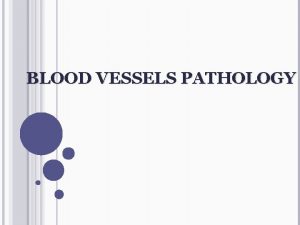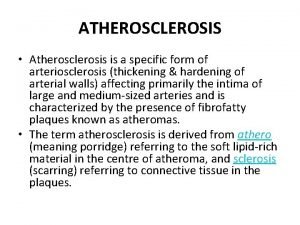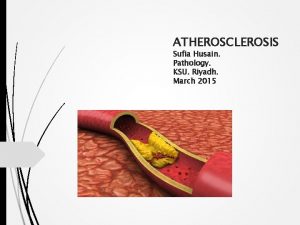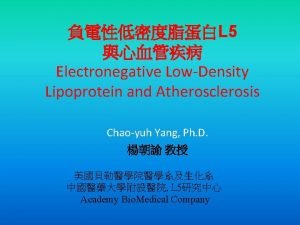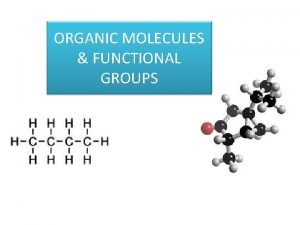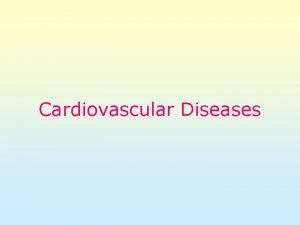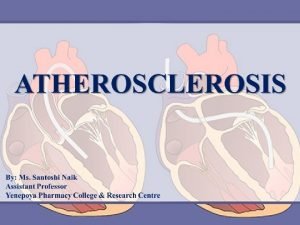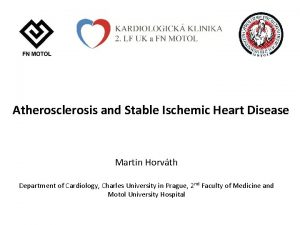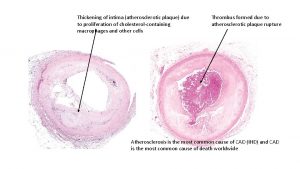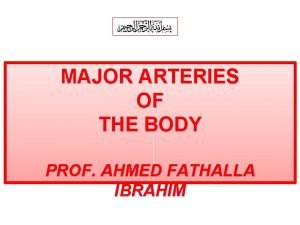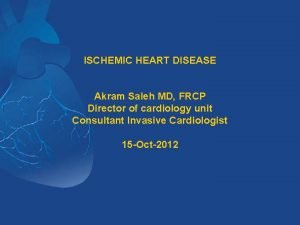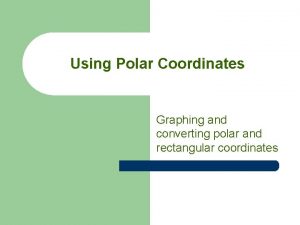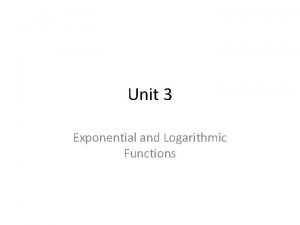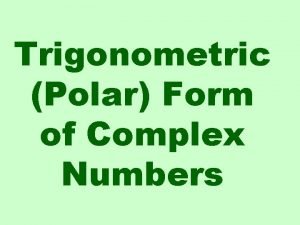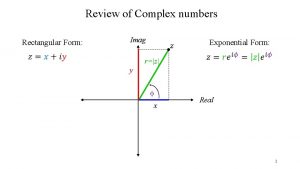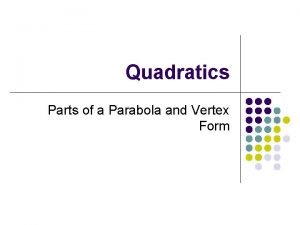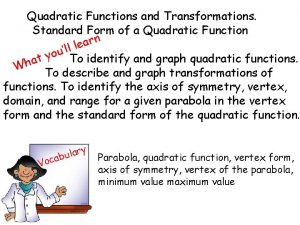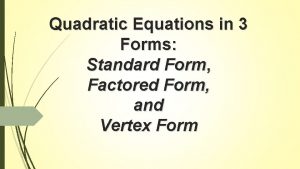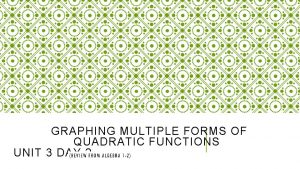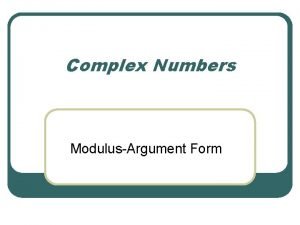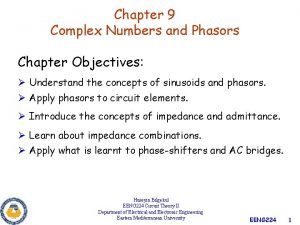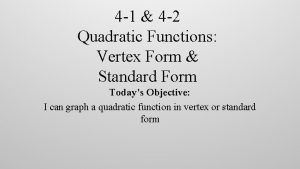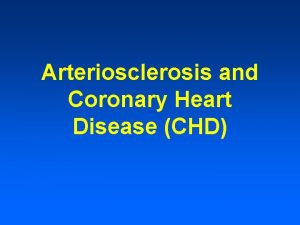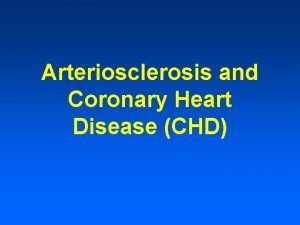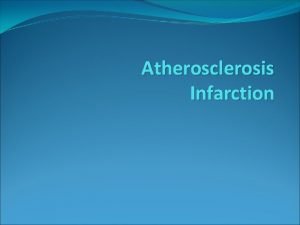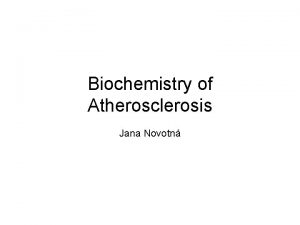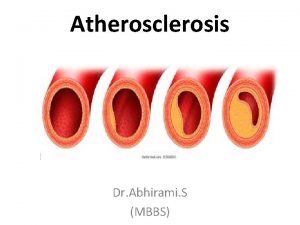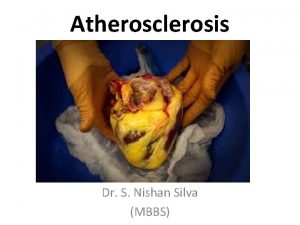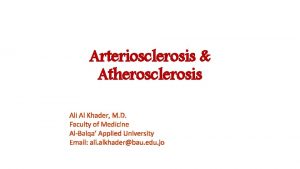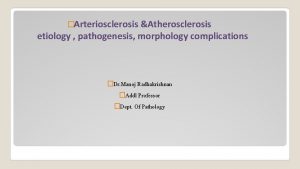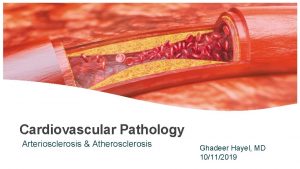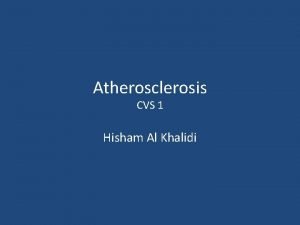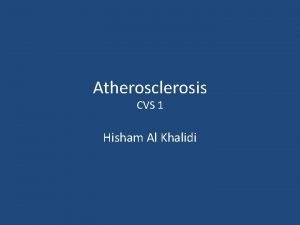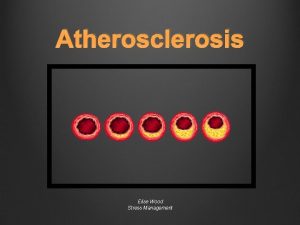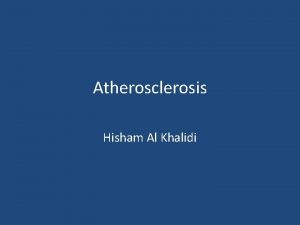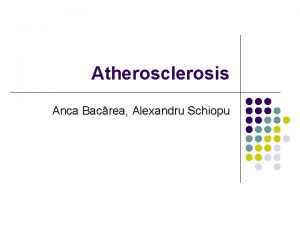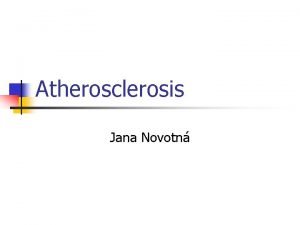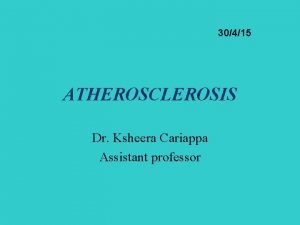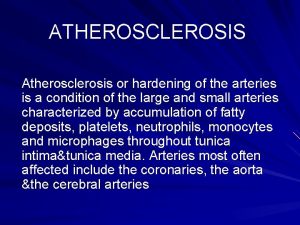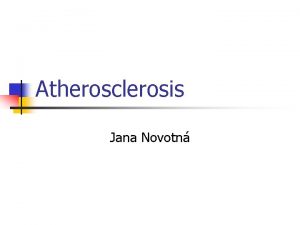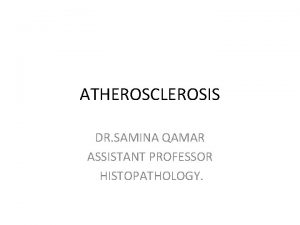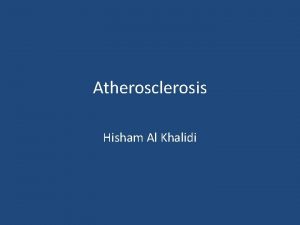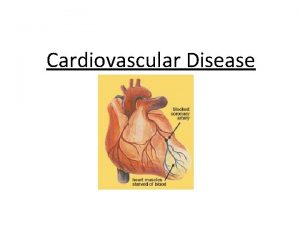ATHEROSCLEROSIS Atherosclerosis is a specific form of arteriosclerosis







































- Slides: 39

ATHEROSCLEROSIS • Atherosclerosis is a specific form of arteriosclerosis (thickening & hardening of arterial walls) affecting primarily the intima of large and medium-sized arteries and is characterized by the presence of fibrofatty plaques known as atheromas. • The term atherosclerosis is derived from athero (meaning porridge) referring to the soft lipid-rich material in the centre of atheroma, and sclerosis (scarring) referring to connective tissue in the plaques.

Atherosclerosis ( contd ) “ While mental disease is our greatest socio – economic problem, cancer our greatest enigma , arthritis and rheumatism our greatest crippler , and accidents our greatest disgrace , atherosclerosis is by far our greatest killer”. - Holman et al.

Risk Factors in Atherosclerosis Major risk factors 1) Major Constitutional risk factors: i. Age ii. Sex iii. Genetic factors iv. Familial and racial factors 2) Major Acquired risk factors: i. Hyperlipidaemia ii. Hypertension iii. Diabetes mellitus iv. Smoking v. Hyperhomocysteinemia

Risk Factors in Atherosclerosis Minor Risk Factors: 1. Environmental influences 2. Obesity 3. Hormones: Oestrogen deficiency, oral contracep. 4. Physical inactivity 5. Stressful life 6. Infections (C. pneumoniae, Herpes virus, CMV) 7. Homocystinuria 8. Role of Alcohol

Risk Factors for Atherosclerosis Major NON-modifiable Minor Modifiable Increasing age Obesity Male gender Physical inactivity Family history Stress ("type A" personality) Genetic abnormalities Postmenopausal estrogen deficiency High carbohydrate intake Modifiable Hyperlipidemia Hypertension Cigarette smoking Diabetes Alcohol Lipoprotein Lp(a) Hardened (trans)unsaturated fat intake Chlamydia pneumoniae

ROLE OF HYPERLIPIDEMIA IN ATHEROGENESIS Ø Hyperlipidemia induces production of superoxide and other O 2 free radicals. Ø With chronic hyperlipidemia lipoproteins accumulates within the intima at sight of endothelial permeability.

ROLE OF HYPERLIPIDEMIA IN ATHEROGENESIS Ø Oxidized LDL has the following effects which may contribute to atheroma formation : a)It is easily phagocytosed by macrophages to form foam cells. b)It is chemotatic for monocytes. c)It increases monocyte adhesion. d)It inhibits the motility of macrophages which are alerady in the lesion.

ROLE OF HYPERLIPIDEMIA IN ATHEROGENESIS e)Stimulates release of growth factors and cytokines. f)It is cytotoxic to endothelial cells and smooth muscle cells. g)It induces production of antibodies to itself.

Schematic diagram of hypothetical sequence of cellular interactions in atherosclerosis

Pathogenesis of Atherosclerosis

PATHOGENESIS OF ATHEROSCLEROSIS


MORPHOLOGY OF ATHEROSCLEROSIS • SITE : In the descending order of frequency Descending abdominal artery, coronary artery, Popliteal artery, Descending thorasic artery, Internal carotid artery, Circle of Willis, Arteries of upper limb and mesentry ( least severe ) • SISE : 0. 5 cm to 1. 5 cm yellow brown colour protruding into the lumen

MILD ADVANCED

ATHEROMATOUS PLAQUE

COMPLICATIONS IN THE ATHEROMATOUS PLAQUE • HAEMORRHAGE INTO THE PLAQUE • ATHEROEMBLISM • ULCERATION AND THROMBOSIS ON THE PLAQUE • CALCIFICATION • ANEURYSM FORMATION

COMPLICATIONS DUE TO ATHEROSCLEROSIS • ISCHEMIC COMPLICATIONS : I. H. D. , CERRBROVASCULAR ACCIDENTS, INFARCTION GANGRENE OF GIT AND LIMBS ETC, • ATHEROEMBOLIM • ANEURYSM FORMATION WITH ITS COMPLICATIONS.

ANEURYSMS DEFINITION : “ LOCALISED ABNORMAL PERMANENT DILATION OF A BLOOD VESSEL OR HEART”.

TYPES OF ANEURYSMS • BASED ON COMPOSITION OF WALL: ( a ) True ( b ) False

Aneurysms ( contd )

Aneurysms ( contd ) • BASED ON SHAPE: (a) Saccular (b) Fusiform (c) Cylindrical (d) Serpentine (e) Racemose (cricoid )

Aneurysms ( contd )

Aneurysms ( contd ) • BASED ON ETIOPATHOGENESIS : (a) Atherosclerotic (b) Syphilitic (c) Mycotic (d) Berry ( congenital ) (e) Traumatic (f) Inflammatory ( Sec to vasculitis ) (g) Hypertensive

COMPLICATIONS OF ANEURYSMS 1. 2. 3. 4. Thrombosis Embolism Rupture and haemorrhage Obstruction of blood vessel and ischemic injury ( Iliac, Renal, Mesentric , Vertebral branches ). 5. Impingement on adjacent tissue like ureter or erosion of vertebra. 6. Presentation as abdominal mass.

AORTIC DISSECTION (DISSECTING HEMATOMA ) • DISSECTION OF BLOOD VESSEL BETWEEN LAMINAR PLANES OF MEDIA WITH THE FORMATION OF BLOOD FILLED CHANNEL WITHIN WALL OF AORTA.

CAUSES 1. Hypertension 2. Connective tissue diseases affecting aorta. e. g. Marfan Syndrome. 3. Iatrogenic : during catheterisation or cardiopulmonary by pass. 4. Rarely due to unknown cause during pregnancy.

TYPES • TYPE A : Invading only the ascending aorta or both the ascending and descending aorta. • TYPE B : Involving only the descending aorta.


ARTERIO-SCLEROSIS • GENERIC term for ANYTHING which HARDENS arteries – Atherosclerosis (99%) – Mönckeberg medial calcific sclerosis (1%) – Arteriolosclerosis, involving small arteries and arterioles, generally regarded as NOT strictly being part of atherosclerosis, but more related to hypertension and/or diabetes


FATTY STREAKS

FUN THINGS TO FIND: Lumen, Fibrous cap (fibrous plaque), Lipid core, External Elastic Membrane thinning/destruction, Calcification, Neovascularization

ANEURYSMS • 2 CAUSES: – 1) ATHEROSCLEROSIS – 2) CYSTIC MEDIAL DEGENERATION (NECROSIS), can be familial NORMAL elastic fibers DISRUPTED, FRAGMENTED elastic fibers

Most abdominal aortic aneurysms (AAA) occur between the renal arteries and the bifurcation of the aorta

Basic processes in atherosclerosis used with permission from M. J. Davies Atlas of Coronary Artery Disease 1998 Lippincott-Raven Publishers

Stage I monocyte adhesion/migration Stage II foam cells (lipid containing macrophages) in intima Stage III appearance of extracellular lipid American Heart Association plaque nomenclature used with permission from M. J. Davies Atlas of Coronary Artery Disease 1998 Lippincott-Raven Publishers

Stage IV Core formation (extracellular lipid coalescing into the center of the plaque) Stage VI Thrombosis Stage V Fibrous Cap and Core formation (fully formed lipid core and well developed cap of fibrous tissue seperating the core from the lumen)

Stable angina. Eccentric coronary stenosis used with permission from M. J. Davies Atlas of Coronary Artery Disease 1998 Lippincott-Raven Publishers

50% 75% 95% Relationship between reduction in diameter and crosssectional area • angiographic view (diameter) • histologic view (cross-sectional area) Arnett EN, Isner JM, Redwood DR, et al. Ann Intern Med 1979; 91: 350
 Arteriosclerosis
Arteriosclerosis Arteriosclerosis
Arteriosclerosis Mild atherosclerosis
Mild atherosclerosis Atherosclerosis
Atherosclerosis Dna structure
Dna structure Superadded changes in coronary atherosclerosis
Superadded changes in coronary atherosclerosis Atherosclerosis
Atherosclerosis Atherosclerosis tunica intima
Atherosclerosis tunica intima Atherosclerosis
Atherosclerosis Atherosclerosis
Atherosclerosis Aortic rupture
Aortic rupture Atherosclerosis plaque development
Atherosclerosis plaque development How to calculate specific gravity
How to calculate specific gravity Applications of specific gravity
Applications of specific gravity Present continuous negative interrogative
Present continuous negative interrogative Types of media codes
Types of media codes What is vertex form
What is vertex form How to convert polar form to rectangular form
How to convert polar form to rectangular form Example of exponential equation
Example of exponential equation Trig form
Trig form General and standard form of a circle
General and standard form of a circle Standard form equation of a circle
Standard form equation of a circle Rectangular
Rectangular How to find vertex of a quadratic function
How to find vertex of a quadratic function Vertex form from standard form
Vertex form from standard form Standard transformation form
Standard transformation form Factored form in quadratics
Factored form in quadratics Example of unnormalized table to normalized
Example of unnormalized table to normalized Short forms
Short forms Is y=x^2 exponential
Is y=x^2 exponential Maxwell 4 equation
Maxwell 4 equation Quadratic graph
Quadratic graph General form to vertex form
General form to vertex form Writing equations of lines review for quiz
Writing equations of lines review for quiz Convert equation to rectangular form
Convert equation to rectangular form Multiplying modulus argument form
Multiplying modulus argument form Adding phasors
Adding phasors Quiz 7-2 logarithmic expressions and functions
Quiz 7-2 logarithmic expressions and functions Logarithmic to exponential form
Logarithmic to exponential form How to find the vertex of a function
How to find the vertex of a function
